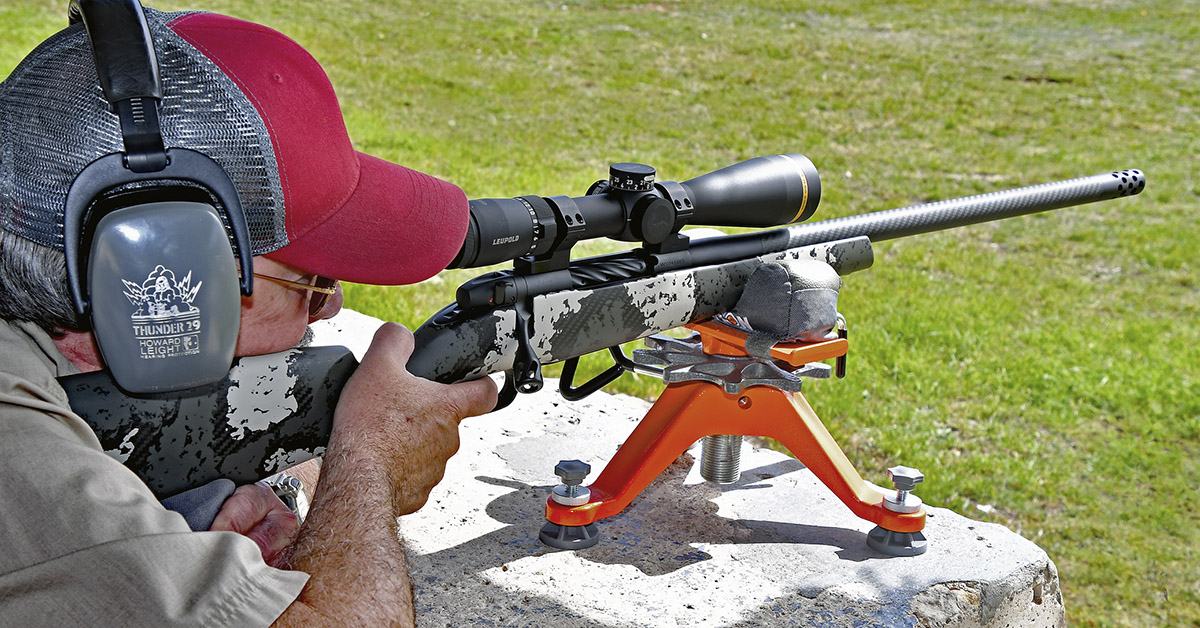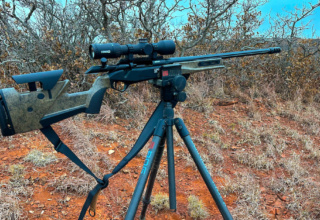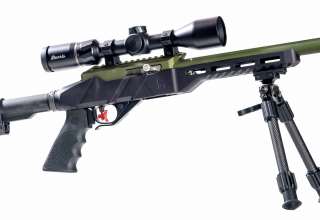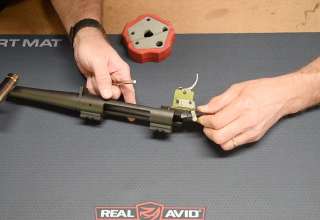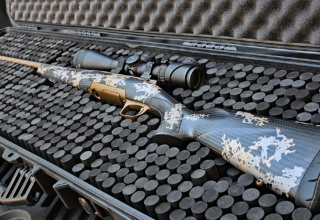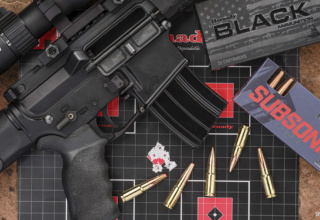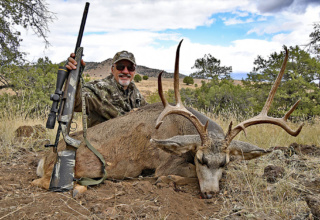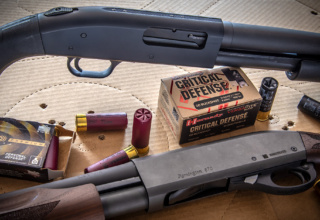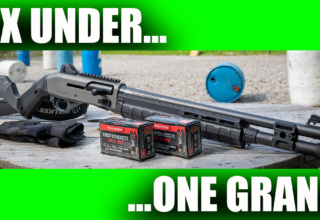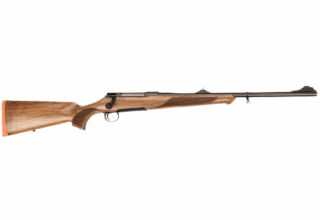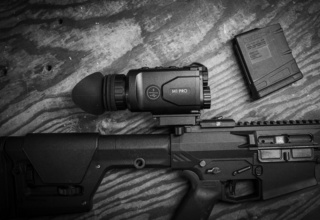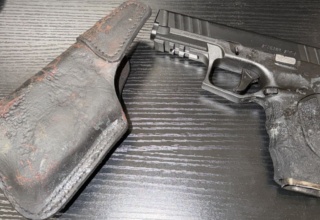Light weight and accuracy don’t always go together, but they do in Weatherby’s lightest-yet entry in the Backcountry line, the Mark V Backcountry Guide Rifle
by Mike Dickerson
Every time I pick up a new rifle, I work the action, test the trigger, examine fit and finish, and check the gun’s balance in my hands. Sometimes, a little voice in my head says, “This one’s a shooter.”
At least that’s the hope. Weatherby’s new Mark V Backcountry Guide rifle fulfilled that wish. Light weight and consistent accuracy don’t always go together, but they do with this rifle. The gun delivered impressive accuracy in testing despite the fact that the rifle weighs just 5.4 to 6.4 pounds, depending on chambering. That’s lighter than Weatherby’s Mark V Backcountry 2.0 Carbon rifles, and largely due to the use of shorter barrels measuring 20, 22 or 24 inches in most chamberings. This makes the gun handier in cover and ideal for use with suppressors.
Multiple Chamberings
Happily, there’s no shortage of chamberings for the Backcountry Guide. Weatherby currently offers the gun in 13 chamberings. Many are popular and common cartridges and several are proprietary Weatherby cartridges. Options include .240 Weatherby. Mag, .243 Win., .257 Weatherby Mag, .280 Ackley Improved, .300 Weatherby Mag, .300 Win., .308 Win., 6.5 Creedmoor, 6.5 Weatherby RPM, 6.5-300 Weatherby Mag, .300 PRC, 7mm Backcountry, and 7mm PRC. A half-dozen cartridge chamberings are available in left-handed rifles.
Carbon is the Key
One of the first things you’ll notice about the rifle, besides its light weight, is its tensioned BSF carbon fiber barrel. With this barrel, a carbon fiber sleeve is loaded under tension around a 416R stainless-steel, match-grade barrel. BSF says this barrel design has a 95% air gap between the carbon fiber and steel. This is to promote faster cooling and to prevent delamination. Because the carbon fiber expands at the same rate as the steel, vibration is dampened. Absent laboratory testing, I can’t verify these claims. I can tell you that bullets did not walk as the barrel heated up. Furthermore, there was little difference in group sizes, whether I was shooting with the barrel hot or cold.
Fortunately, the shorter barrel did not sacrifice much velocity. Chambered in 6.5 Creedmoor, my test rifle had a 22-inch barrel threaded 5/8-24 and tipped with a Weatherby radial titanium brake. On average, velocities for four test factory loads were just 33 fps below factory-stated numbers. That isn’t enough to make a difference in the field.
Premium Interface
The Backcountry Guide is, of course, built upon the time-proven Weatherby Mark V action, with some improvements. An example is the deeply spiral-fluted, weight-saving bolt that makes a smooth-cycling action even smoother. Actions for non-magnum chamberings use a bolt with six locking lugs while magnum chamberings still utilize a nine-lug bolt. One standout feature of the action is the short, 54-degree bolt throw, which allows more-than-ample scope clearance and aids in running the gun fast. You can also easily replace the skeletonized bolt knob with one of your choosing. The action has a two-position safety that locks the bolt down in the engaged, safety-on position, which I prefer on a hunting rifle.
It can be extremely challenging to shoot featherweight rifles accurately without a good trigger, and the Backcountry Guide checks this box. It’s equipped with an excellent, externally adjustable TriggerTech trigger. I adjusted it down to a pull weight of 2 pounds, five ounces, and found that the trigger broke crisply, with no hint of creep and little over-travel.
The rifle employs a hinged-floorplate magazine adorned with a topo map pattern and Backcountry logo. All external metal wears a protective graphite black Cerakote finish. Functionally, the rifle ran with nary a hiccup in feeding, extraction, and ejection.
Good Ergonomics
Weatherby equipped the Backcountry Guide with one of the industry’s lightest production carbon fiber stocks — the Peak 44 Blacktooth. With this stock, a carbon fiber bedding block mates with the front recoil lug, transferring recoil force to the outer shell of the stock. Recoil is further reduced with a 3D Hex recoil pad that combined with the brake on my test rifle to effectively mitigate recoil.
The stock has mostly classic lines. The comb, though, has a bit of negative slope to help achieve optimal eye-scope alignment. A flattened bottom on the forend aids in shooting from bags or rests. Each Backcountry Guide rifle has a distinctive and attractive look, to my eye, because each stock is painted by hand with olive green and backpack sponge pattern accents.
In addition to traditional sling swivel studs, the stock is equipped with two flush-fitting Spartan Precision Equipment gunsmith adaptors. These work with Spartan’s line of ultra-light bipods and accessories. One adaptor is located on the bottom of the forend near the rifle’s center balance point. This is perfect for attaching the rifle to a tripod. The other is located just behind the front swivel stud for attaching a bipod. With the Spartan system, accessories attach and detach instantly using rare-earth magnets. This gives you great flexibility in the field to adapt to circumstances dictated by the terrain or vegetation.
On the Range
For range testing, I used a set of Talley lightweight rings to mount a Leupold VX-5HD 3-15×44 scope. Since this is purely a hunting rifle, I deliberately chose to exclude match ammo from testing and tested only hunting ammo at the traditional 100-yard distance. With all torque settings double checked, I set out to see if the rifle would live up to Weatherby’s sub-MOA accuracy guarantee, shooting three three-shot groups per load.
Of the four loads tested, Hornady’s 143-grain ELD-X Precision Hunter load actually delivered sub-one-half-MOA performance, printing 0.47-inch average groups and a best group measuring just 0.31 inches. Winchester’s 142-grain AccuBond Long Range load wasn’t far behind with a 0.47-inch best group and 0.65-inch average groups. A 140-grain Federal Fusion load also delivered sub-MOA average groups. That’s phenomenal performance when you consider that I did all testing on a day when I had to contend with a full-value wind blowing 5-13 mph.
Only one load, the Barnes VOR-TX LR 127-grain load, narrowly missed the sub-MOA mark, and there’s a reason for that. I shot the Barnes load last, and it’s no secret that accuracy can fall off a bit if you switch from shooting traditional bullets to all-copper bullets, or vice versa, without cleaning the gun. I didn’t clean the barrel before I shot the copper load because I was pressed for time. I’m confident, based on my experience, that if I had, groups with the copper bullet would have tightened up. In any event, the load still delivered perfectly acceptable hunting accuracy with 1.20-inch average groups and a 1.05-inch best group.
An Investment in Performance
I have seldom tested a lightweight rifle that shot this well. Such performance doesn’t come cheap. The Backcountry Guide rifle has a MSRP of $3,299, but that’s the price of admission if you want a rifle built from such premium components. For $500-$700 more, you can buy an even lighter version of this rifle, the Backcountry Guide Ti, which has a titanium action and weighs 5.2-5.9 pounds.
Weatherby Mark V Backcountry Guide Specifications
- Caliber: 6.5 Creedmoor, as tested
- Action: Bolt-action push feed
- Barrel: BSF tensioned carbon fiber/stainless steel, 22 in.
- Twist Rate: 1:8
- Threaded: 5/8-24
- Muzzle Brake: Radial titanium Accubrake ST
- Action Finish: Graphite black Cerakote
- Trigger: Adjustable TriggerTech
- Stock: Peak 44 Blacktooth carbon fiber
- Magazine: Hinged floorplate
- Capacity: 4+1
- Sights: None, drilled and tapped
- Weight: 5.6 lbs.
- Overall Length: 42 in.
- Length of Pull:13.5 in.
- MSRP: $3,299
- Pelican Re-Set: One Rifle Case to Rule Them All? - October 8, 2025
- Hornady’s New .338 ARC: The .300 Blackout Killer? - June 2, 2025
- TESTED: Weatherby’s New Mark V Backcountry Guide Rifle - April 18, 2025








